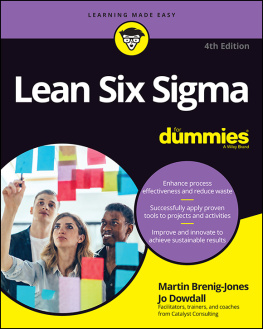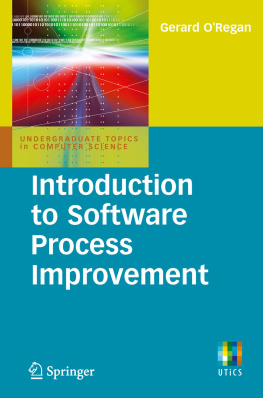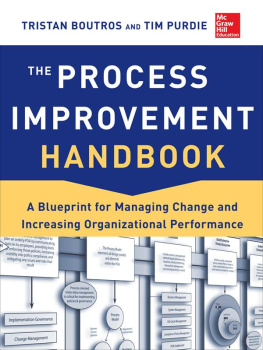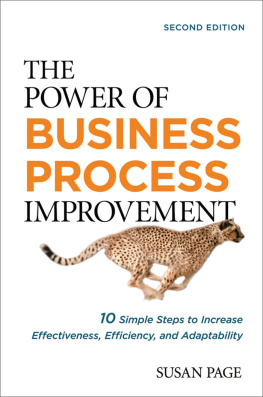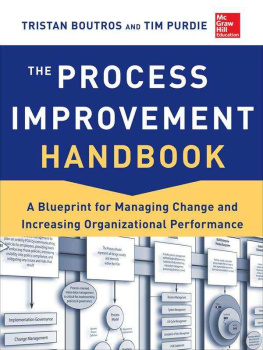Preface
THIS BOOK IS NOT INTENDED AS A COMPREHENSIVE LOOK AT THE ART AND TECHNIQUE OF PROCESS improvement, nor is it intended to give you a complete look at ISO 9001:2000, CMMI, or Six Sigma. Those types of books are already out there. The weighty thing about them is that they are comprehensive, filled with good information, depth, and a lot of material. Sometimes they contain more than what you might be looking for initially.
Because I work in the field of process improvement, it is not uncommon for people to come up to me at trade shows or after seminars or at organizational meetings and ask my opinion about one of these three well-known programs.
They want an answer that's less than comprehensive. (In fact, they often want an answer that's less than useful.) Two or three sentences to the query: Which program should we adopt? Or, what's the difference between these three? Or, what would it cost to get certified? Those are questions none of us can answer in a three-minute conversation. But I've tried to come close to that in this slim volume.
The chief purpose of this book is to help people who are new to process improvement get a basic understanding of the purpose, aim, and structure of this growing field and to help them understand how ISO 9000, CMMI, and Six Sigma relate to the industry and to one another. It's also designed to help set beginners on the way to making an informed decision, should they wish to move into deeper exploration along more specific lines.
In of this book, I'll begin by taking a general look at the intent of process improvement. Today's technologies industries are becoming more and more quality-conscious, especially as IT budgets grow and represent bigger and bigger expenditures within corporations. Waste, inefficiencies, and compromised quality can have a dramatic impact on a company's competitive position and its success in the marketplace. So technology managers are more and more attuned to the business nature of their missions. And they realize that there are very real business advantages to process management.
Next, in , the sections that describe each component of the quality program.
After I look at ISO, I'll look at the Capability Maturity Model from the Software Engineering Institute, a foundation based out of Carnegie Mellon University in Pittsburgh. (The latest release of this program is actually named CMMI-Dev, Version 1.2, with the "I" standing for Integration and the "Dev" standing for Developmentan integrated model intended for development organizations.) CMMI integrates quality recommendations for systems engineering, software engineering, and integrated product and process development. You'll notice that's a more constrained focus than ISO 9001:2000. ISO is shaped for any manufacturing enterprise. CMMI is specially designed for technology companies, especially those that deal in some form or fashion with the design and development of software. CMMI is structured differently from ISO. It's shaped as a collection of Process Areas, each with a series of goals and practices designed to help you reach those goals. I'll look at each Process Area in CMMI and then look at ways an organization can implement the Process Areas to reach its own quality goals.
I'll also take a look at Six Sigma. Six Sigma is a quality program that's been used to great extent and with great success at companies such as Honeywell, Motorola, and (most famously) General Electric. Six Sigma is a way to measure quality by measuring a company's ability to meet the needs of its customers through process refinement and process improvement. It's highly customer focused and highly data-centric. One of its core philosophies is that decisions should not be made on gut instinct alone. Instead, decisions should be made based on hard data, and that data should be collected from sources that support the needs of the customers. Unlike ISO and CMMI, Six Sigma is not published or regulated by a central body. It is a free-floating program, but as its user community increases, more and more support for its application is coming into the market. I'll look at the intention and philosophy of Six Sigma and then delve into its methodology, DMAIC. Then I'll look at some basic statistical tools that can help support a Six Sigma program.
The Audience for This Book
This book is intended for people who are new to process improvement. It is written for people who want to know more about process improvement and about the process improvement programs most popular today.
Most technology companies can benefit from some kind of process management focus. This became painfully apparent when the dot-com bubble burst around 2000. At that time, it seemed the software industry was going haywire and the venture capital industry was on for the ride. Hundreds of millions of dollars were being pumped into the most superfluous of concepts. Companies funded to the teeth literally appeared overnight: frenzied operations racing toward some ill-defined finish line. Amazingly, the management at a large portion of these start-ups was incredibly naive. They paid little attention to integrated design, to team organization, to product requirements, to even the most basic of business school management fundamentals.
Today the industry is becoming wiser. The fact that there is increased interest in ISO, CMMI, and Six Sigma is an indicator of that. This is a good trend, but it has not yet matured.
While more and more companies are looking at the potential benefits of process management and process improvement, they have a tendency to appoint internal people to carry the torch for them, people who have a vested interest in the outcome but who have little or no formal training in process improvement or much exposure to the facets of the field.
This book is intended for those people who would like to get a starting foundation in process improvement. For the focus of this book, these people typically fall into two general groups.
Process Managers
The term process manager is pretty softly defined in the industry right now. Scott Brenner is an IT director, but his company singled him out to lead its process charge. From my practice, this is the way I have seen more and more companies get into formal process improvement. They appoint an insider to shape the new capability. They may plan to fund it appropriately and to give it the kinds of experienced resources those kinds of teams need. They may even move to suggest what the program of choice will be. But early on, the process manager is typically left to take the first steps into uncharted territory and to do it somewhat alone.
People in this position are usually appointed for several reasons. They typically know their organizations, they know the ins and outs of their IT operations, they know their people and the culture, and they know a lot about the current problems and issues. But they probably don't know a lot about process improvement.



